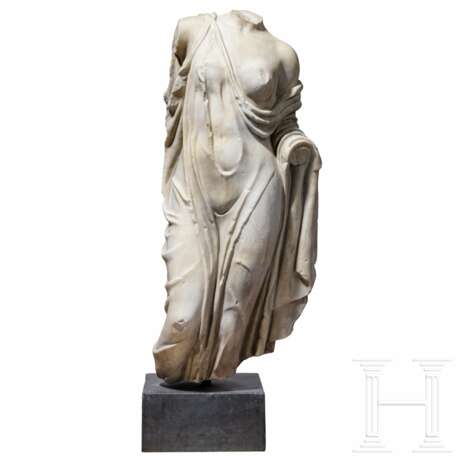Klassizistische Marmorstatue nach dem Vorbild der hochklassischen Aphrodite des Typus "Fréjus", um 1800 - frühes 19. Jhdt.
14.05.2024 10:00UTC +01:00
Classic
Starting price
8000EUR € 8 000
| Auctioneer | Hermann Historica |
|---|---|
| Event location | Germany, Grasbrunn / München |
| Buyer Premium | 25 % |
Archive
The auction is completed. No bids can be placed anymore.

ID 1198600
Lot 77 | Klassizistische Marmorstatue nach dem Vorbild der hochklassischen Aphrodite des Typus "Fréjus", um 1800 - frühes 19. Jhdt.
Unterlebensgroßer Marmortorso einer Aphrodite des Typus Fréjus. Das hochklassische Vorbild (um 420 v. Chr.) gilt als eine Schöpfung des Kallimachos. Von dem Typus existieren zahlreiche Kopien aus römischer Zeit in unterschiedlich feiner Ausführung (u. a. aus Pergamon und Delos sowie Exemplare im Museum von Neapel und im Louvre). Charakteristisch sind das linke Standbein und das rechte, zur Seite gestellte Spielbein. Die Figur trägt einen ungegürteten Chiton, der von der linken Schulter gerutscht ist und die linke Brust entblößt. Der Kopf ehemals zur Standbeinseite gedreht. Die erhobene Rechte zieht den über den Rücken gelegten Mantel, der seitlich über den linken angewinkelten Arm herabfällt, über die rechte Schulter. Der linke Unterarm nach vorne weisend. Füße knapp oberhalb der Sprungelenke abgebrochen. Die linke Hand mit dem vorderen Unterarm sowie der rechte Arm fehlen, gleichfalls der Kopf. Wohl bewusst als Torso geschaffen. Sorgfältig gereinigte Oberfläche. Modern mit schwerem Stahlstift auf einen schwarzen Steinsockel montiert. Bei der Montage wurde die Achse der Skulptur nicht ganz korrekt beachtet und kippt etwas nach rechts. Qualitativ sehr hochwertige Kopie eines hochklassischen Bildwerkes, das als Typus zahlreiche Werke der antiken Skulptur und Kleinkunst inspiriert hat. Höhe ca. 90 cm (mit Sockel 108 cm), Breite ca. 44 cm, Tiefe ca. 30 cm.
Provenienz: Aus der Sammlung Dr. H. Lanz, München. Erworben in den 1980er Jahren aus einer französischen Privatsammlung in Antibes.
A Neoclassicistic Aphrodite statue modeled on the high-classical Aphrodite of the "Fréjus" type, circa 1800 - early 19th century
A Neoclassicistic Aphrodite statue modeled on the high-classical Aphrodite of the "Fréjus" type, circa 1800 - early 19th century
Smaller than life-size marble torso of an Aphrodite of the Fréjus type. The high-classical model (around 420 B.C.) is considered a creation of Kallimachos. There are numerous copies of this type from Roman times in varying degrees of fineness (including items from Pergamon and Delos as well as examples in the Naples Museum and the Louvre). The left supporting leg and the right free leg, which is set to the side, are characteristic. The figure wears an unbelted chiton that has slipped off the left shoulder, exposing the left breast. The head was previously turned to the supporting leg side. The raised right hand pulls the coat that is draped over the back over the right shoulder, which falls down to the side over the bent left arm. The left forearm pointing forward. Feet broken off just above the hocks. The left hand with the front forearm and the right arm are missing, as is the head. Probably deliberately created as a torso. Surface thoroughly cleaned. Recently mounted on a black stone base with a heavy steel pin, which does not perfectly match the axis of the statue and tilts slightly to the right. Very high quality copy of a high-class work of art, which as a type has inspired numerous works of ancient sculpture and minor arts. Height ca. 90 cm (with base 108 cm), width ca. 44 cm, depth ca. 30 cm.
Provenance: From the collection of Dr. H. Lanz, Munich. Acquired in the 1980s from a French private collection in Antibes.
Condition: II -
| Auction house category: | Reception of Antiquity |
|---|
| Auction house category: | Reception of Antiquity |
|---|
| Address of auction |
Hermann Historica Bretonischer Ring 3 85630 Grasbrunn / München Germany | ||||||||||||||
|---|---|---|---|---|---|---|---|---|---|---|---|---|---|---|---|
| Preview | |||||||||||||||
| Phone | +49 (0)89 5472 649 0 | ||||||||||||||
| Fax | +49 (0)89 5472 64999 | ||||||||||||||
| Buyer Premium | 25 % | ||||||||||||||
| Conditions of purchase | Conditions of purchase | ||||||||||||||
| Business hours | Business hours
|


